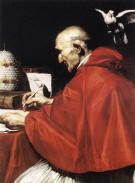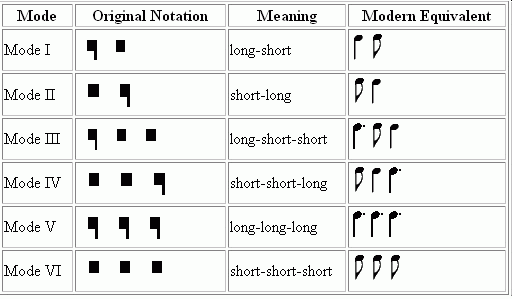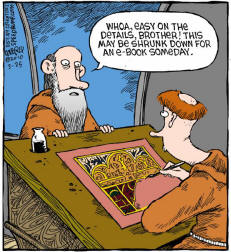 Pope Gregory I (The Great) was the leader of the Catholic church from 590-640. He organized and formalized the order of liturgy for church services throughout the world that remained intact until the 1600's. Legend has it that he composed all the melodies in use by the church, under divine inspiration. Although it is doubtful that he composed all the melodies (if he composed any at all), he did establish the music type that would bear his name, Gregorian Chant.
Pope Gregory I (The Great) was the leader of the Catholic church from 590-640. He organized and formalized the order of liturgy for church services throughout the world that remained intact until the 1600's. Legend has it that he composed all the melodies in use by the church, under divine inspiration. Although it is doubtful that he composed all the melodies (if he composed any at all), he did establish the music type that would bear his name, Gregorian Chant.
Music in the early church was not sung to impress others with one's musicianship, or performed for the sheer beauty of sound; music was the servant of religion. Only music that opened the mind to Christian teachings or inspired the listener to 'holy thoughts' was allowed in church. Since they believed that music without words cannot do this, at first they excluded instruments from the church. They also did not allow large choruses, elaborate singing and dancing. The church had a practical reason for banning these elements - these large spectacles and 'entertainment' was associated with pagan rituals that the church was trying to abolish.
As the Christian faith spread from southern Europe to the rest of the world, missionaries carried the melodies and customs with them. From these seeds our Western music sprung.
 Gregorian Chant -Kyrie
Gregorian Chant -Kyrie
When our modern ears first hear Gregorian Chant, we might be struck by all the things this music is lacking:
- no harmony or accompaniment
- no 'beat' or regular accents
- no ending as we would expect it to end
- no attempt to thrill or elicit an emotional response
Assignment #2 - Is it or Not? Quiz
Listen to music examples and tell whether they are Gregorian Chants or not (based on this definition by Donald Grout). And if they are not, tell why they are not.
There are also a few questions about other items presented in this lesson
.
|
Donald Grout defines Gregorian Chant as
"a single-lined melody sung to Latin words by unaccompanied men's voices, in a flexible rhythm...in a scale system different from our major or minor; and has an impersonal, objective, other worldly quality in which sensuous beauty and emotional appeal are largely subordinate to expression of the religious context of the text."
Gregorian chant melodies generally reflect the Latin text being sung; important words are sung on higher pitches and given more notes. Chant melodies have phrases; usually the melody starts low, rises to higher pitches where it remains for a while, and then descends at the end of the phrase.
Gregorian Chant was not meant to be listened to for its' own sake, but rather as a part of a worship service. It was functional music, it served a purpose. The words are from biblical stories and liturgical text. Many of the tunes were as familiar to the common man as any folk tune. Children learned them in school. They were sung in church, and since at this time in history almost everyone went to church, everyone knew the tunes - it was the music of the people.
Up until the eighth century the singing of the chants was improvisatory: not that the singer was 'making up' the melody, but rather they would base their melodic lines on the tunes established for the particular prayers or seasons of the church. This meant the singer had to have a good memory. By the end of the eighth century the number of tunes had increased to a point where singers had difficulty keeping text/tune combinations. It became necessary to fix the melodies in writing. The early musical notation was not an exact representation of the melody, it was more of a reminder to jog the singers memory. The church saw music notation as a way to create uniformity among it's followers.

When we first look at the written chant notation, we realize it does not have the same symbols and form as modern music. There is a staff, but instead of our current 5 line staff, we see 4 lines. Instead of a Treble or Bass clef, we see a symbol like  . at the beginning of the line. We don't see rhythm symbols or key signatures.
. at the beginning of the line. We don't see rhythm symbols or key signatures.
On YouTube | Click here for closed caption video | Click here if the video above is blocked | transcript of video
 The First Music Notation
The First Music Notation
In the beginning, signs were placed over the written text: / to indicate a rising melodic line, \ a descending one, and ^ for a rise and fall. By the tenth century scribes were placing marks at varying heights above the words to appropriate note placement. Soon, a single line (that represented the pitch F) was drawn and notes (called neumes) were placed above and below to indicate relative pitch.
Soon, another line was added and then another and then the fourth line we see above. The  indicated where middle C was and the position of the notes indicate pitch and duration. Look at the comparison below between Gregorian neumes and modern interpretation of the same melody.
indicated where middle C was and the position of the notes indicate pitch and duration. Look at the comparison below between Gregorian neumes and modern interpretation of the same melody.

Late Medieval Music Characteristics
Three changes in music took place during this time :
1. Composition instead of improvisation. Before now, all performances were a little different. Although the performers might be singing or playing the same melody, each performance would differ at least slightly because the tunes were always interpreted by the performer on the spot. Now, a piece of music was performed the same way during each performance.
2. Invention of Musical Notation. A composed piece of music could be taught and passed on orally by the composer or another that knew the music. (However, the performer or the listener could interpret the music incorrectly). Musical notation allowed for a written set of instructions that could allow a performer to learn the music whether or not the composer was present. Thus, composition and performance became separate acts - it became the job of the musician to bring the work of the composer to the audience.
3. Polyphony began to replace monophony. Polyphony is defined as "a style of musical composition employing two or more simultaneous but relatively independent melodic lines". Now, instead of all musicians singing the same notes together, singers sang different notes at the same time, creating parts and harmony.


Rhythmic Modes
When music was just one part sung by all (Gregorian Chant), or two parts paralleling a melody (organum), precise rhythmic notation wasn't necessary. But once parts started moving independently from each other, each with their own melodies and rhythms (Notre Dame Organum), composers needed to have a way to notate rhythmic changes.
But instead of using the rhythmic notation we use today, they devised a system called 'rhythmic modes'. Six rhythmic patterns were identified: musicians of the time learned the six patterns, and their use was notated by the use of ligatures - groupings of the notes on the staff.
 Pope Gregory I (The Great) was the leader of the Catholic church from 590-640. He organized and formalized the order of liturgy for church services throughout the world that remained intact until the 1600's. Legend has it that he composed all the melodies in use by the church, under divine inspiration. Although it is doubtful that he composed all the melodies (if he composed any at all), he did establish the music type that would bear his name, Gregorian Chant.
Pope Gregory I (The Great) was the leader of the Catholic church from 590-640. He organized and formalized the order of liturgy for church services throughout the world that remained intact until the 1600's. Legend has it that he composed all the melodies in use by the church, under divine inspiration. Although it is doubtful that he composed all the melodies (if he composed any at all), he did establish the music type that would bear his name, Gregorian Chant.
 The First Music Notation
The First Music Notation 



